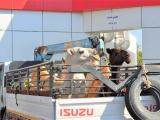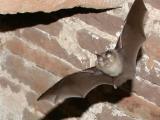A large study of blood samples in Saudi Arabia suggests that some people who have contact with camels can contract undiagnosed or only mild MERS-CoV infections and might unknowingly pass the disease to others, findings that may help solve the mystery of how some people are getting sick.
The long-awaited seroprevalence study by a German and Saudi research team also found that camel shepherds and slaughterhouse workers had antibodies against the virus that were 15 to 23 times higher than the general population, adding more evidence that camels are a natural host for the virus.
The group, which included Christian Drosten, MD, a virologist at the University of Bonn, and Ziad Memish, MD, with King Abdulaziz Medical City and Alfaisal University in Riyadh, Saudi Arabia, published their findings yesterday in The Lancet Infectious Diseases.
Drosten hinted at the study's main findings in an interview with Science that was published Mar 20.
Also, Saudi Arabia's Ministry of Health (MOH) reported one new case, and the World Health Organization (WHO) posted an update on 12 recent MERS-CoV (Middle East respiratory syndrome coronavirus) cases from the country.
One new case, and a recent death
According to the MOH update today, the latest confirmed case-patient is an 82-year-old Saudi man from the city of Ha'il, located in the northwestern part of the country. He has disease symptoms and is listed in stable condition. The investigation so far suggests he didn't have contact with suspected or confirmed cases.
Also, on Apr 7 the MOH announced that 39-year-old man whose illness was announced earlier had died from the disease. The man was a Saudi from Khafji in the northeastern region who is not a healthcare worker and didn't have underlying medical conditions.
Yesterday the MOH announced another recovery from the disease, in a 63-year-old male foreign health worker from Jeddah, raising that total to 542.
The latest infection and death lift Saudi Arabia's MERS-CoV total to 977 cases, which includes 425 deaths. The WHO also noted that the country informed it of two deaths in previously reported patients.
WHO: 7 patients had known exposures, 4 with camels
The update from the WHO today fleshes out more details on 12 MERS-CoV cases reported by Saudi Arabia between Mar 24 and Mar 31. Two of the patients died from their illnesses, an 80-year-old man from the Tabuk region who had an underlying health condition and a 54-year-old man from Hofuf who had frequent contact with camels and drank raw camel milk.
Among the other 10 patients, 9 are hospitalized, including 7 in stable condition and 2 in critical condition. One has been released from the hospital and is on home isolation.
Exposure to the virus isn't known yet for five of the patients. Four had contact with camels and consumed camel milk, including one who had also been exposed to sheep. Two were foreigners who had contact with previously confirmed cases, one in Riyadh and one in Jeddah. One patient is a health worker who provided care to a lab-confirmed MERS patient.
Illness onsets range from Mar 2 to Mar 28. The group includes 10 men and 2 women, and they range in age from 20 to 80 years old.
The dozen new Saudi cases boosts the global MERS-CoV total reported to the WHO to 1,102 cases, with at least 416 deaths. Most have been in Saudi Arabia.
Serology study fills in more gaps
The German and Saudi team's work is the first nationwide population-based seroepidemiologic study of MERS-CoV. Using a cross-sectional study design, they tested blood samples from 10,009 people in Saudi Arabia whose age and sex profile are similar to the country's general population.
They also looked at blood samples from camel shepherds and slaughterhouse workers.
The blood samples they used had been obtained for other public health purposes, about 5,700 from primary health clinics collected in April through June of 2013 and about 4,200 between Dec 2012 and Dec 2013 from primary health centers.
The collection included samples from all 13 of Saudi Arabia's provinces. The investigators found MERS-CoV antibodies in 15 people, or 0.15%. Men were more likely to have signs of infection than women, and researchers saw no age-related patterns. Positive findings were more common in central rural areas than in coastal regions—14 of the positive samples were from central rural residents, and 1 was from a coastal district.
The team also obtained samples from 87 camel shepherds who participated in a health ministry surveillance study in the first half of 2014 and from 140 foreign slaughterhouse employees working in Mecca in August 2013. Two shepherds and 5 slaughterhouse workers had MERS-CoV antibodies, for rates of 2.3% and 3.6%, respectively.
None of the people who had MERS-CoV antibodies had severe infection when they were sampled, and the age of those who seroconverted was lower than in patients who have been admitted to the hospital for the disease.
The team concluded that middle-aged men who have regular contact with camels may sporadically transmit the virus to the general population, and the subclinical or mild infections—especially in younger people—might be the source of unknown sources of exposure reported for many MERS patients.
The researchers noted that antibodies were seen across a wide part of Saudi Arabia, even in areas that haven't reported outbreaks. Extrapolating their findings to the general population, they estimated that as many as 44,951 people in Saudi Arabia may have MERS-CoV antibodies, though Drosten in last month's Science story called the extrapolation "a bit risky."
Study clarifies patterns, but questions remain
In a commentary on the study in the same issue, two infectious disease experts wrote that the study is the first well-designed, credible seroepidemiologic study of MERS-CoV, and that evidence is building that dromedary camels are the natural host. The authors are Ghazi Kayali, PhD, MPH, a virologist at St. Jude Children's Research Hospital in Memphis, Tenn., and Malik Peiris, PhD, a microbiologist at the University of Hong Kong.
Camels' role has been controversial, because many sick people had no contact with them, case-control studies haven't been done, and an earlier seroprevalence study in people who had contact with camels found no association.
The two experts, though, said the study findings suggest that young Saudi Arabian men who have occupational or cultural contact with camels are contracting the virus, often without being diagnosed, and introducing the virus to the general population, where the more severe cases are prompting testing and identification.
The group's study paints a clearer picture of disease epidemiology, Kayali and Peiris wrote. "Camels seem to be a natural host for MERS-CoV, and transmission within camel herds is well established."
They said several questions still need to be resolved, however, such as how camels are infecting people, whether an intermediate host is carrying the virus between camels and people, and if dromedaries are the natural reservoir or an amplifier host.
See also:
Apr 8 Lancet Infect Dis abstract
Apr 8 Lancet Infect Dis commentary extract
Mar 23 CIDRAP News item on Science story
Apr 9 MOH statement
Apr 9 WHO update
Apr 7 MOH statement
Apr 8 MOH statement




















